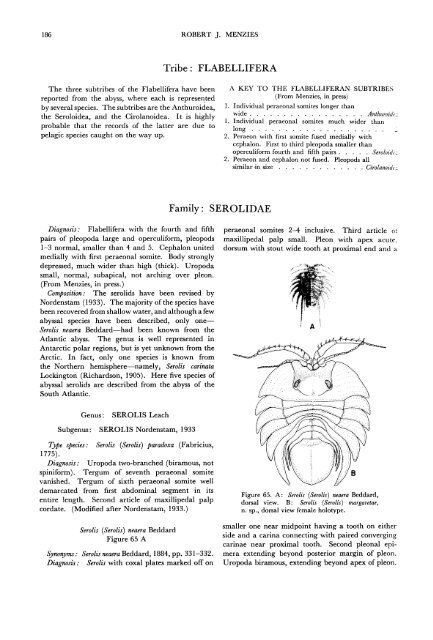The Isopods of Abyssal Depths in the Atlantic Ocean
The Isopods of Abyssal Depths in the Atlantic Ocean
The Isopods of Abyssal Depths in the Atlantic Ocean
Create successful ePaper yourself
Turn your PDF publications into a flip-book with our unique Google optimized e-Paper software.
186 ROBERT J. MENZIES<br />
<strong>The</strong> three subtribes <strong>of</strong> <strong>the</strong> Flabellifera have been<br />
reported from <strong>the</strong> abyss, where each is represented<br />
by several species. <strong>The</strong> subtribes are <strong>the</strong> Anthuroidea,<br />
<strong>the</strong> Seroloidea, and <strong>the</strong> Cirolanoidea. It is highly<br />
probable that <strong>the</strong> records <strong>of</strong> <strong>the</strong> latter are due to<br />
pelagic species caught on <strong>the</strong> way up.<br />
Diagnosis: Flabellifera with <strong>the</strong> fourth and fifth<br />
pairs <strong>of</strong> pleopoda large and operculiform, pleopods<br />
1-3 normal, smaller than 4 and 5. Cephalon united<br />
medially with first peraeonal somite. Body strongly<br />
depressed, much wider than high (thick). Uropoda<br />
small, normal, subapical, not arch<strong>in</strong>g over pleon.<br />
(From Menzies, <strong>in</strong> press.)<br />
Composition: <strong>The</strong> serolids have been revised by<br />
Nordenstam (1933). <strong>The</strong> majority <strong>of</strong> <strong>the</strong> species have<br />
been recovered from shallow water, and although a few<br />
abyssal species have been described, only one—<br />
Serolis neaera Beddard—had been known from <strong>the</strong><br />
<strong>Atlantic</strong> abyss. <strong>The</strong> genus is well represented <strong>in</strong><br />
Antarctic polar regions, but is yet unknown from <strong>the</strong><br />
Arctic. In fact, only one species is known from<br />
<strong>the</strong> Nor<strong>the</strong>rn hemisphere—namely, Serolis car<strong>in</strong>ata<br />
Lock<strong>in</strong>gton (Richardson, 1905). Here five species <strong>of</strong><br />
abyssal serolids are described from <strong>the</strong> abyss <strong>of</strong> <strong>the</strong><br />
South <strong>Atlantic</strong>.<br />
Genus: SEROLIS Leach<br />
Subgenus: SEROLIS Nordenstam, 1933<br />
Type species: Serolis (Serolis) paradoxa (Fabricius,<br />
1775).<br />
Diagnosis: Uropoda two-branched (biramous, not<br />
sp<strong>in</strong>iform). Tergum <strong>of</strong> seventh peraeonal somite<br />
vanished. Tergum <strong>of</strong> sixth peraeonal somite well<br />
demarcated from first abdom<strong>in</strong>al segment <strong>in</strong> its<br />
entire length. Second article <strong>of</strong> maxillipedal palp<br />
cordate. (Modified after Nordenstam, 1933.)<br />
Serolis (Serolis) neaera Beddard<br />
Figure 65 A<br />
Synonyms: Serolis neaera Beddard, 1884, pp. 331-332.<br />
Diagnosis: Serolis with coxal plates marked <strong>of</strong>f on<br />
Tribe: FLABELLIFERA<br />
Family: SEROLIDAE<br />
A KEY TO THE FLABELLIFERAN SUBTRIBES<br />
(From Menzies, <strong>in</strong> press)<br />
1. Individual peraeonal somites longer than<br />
wide Anthuroidei<br />
1. Individual peraeonal somites much wider than<br />
long<br />
2. Peraeon with first somite fused medially with<br />
cephalon. First to third pleopoda smaller than<br />
operculiform fourth and fifth pairs Seroloidtc<br />
2. Peraeon and cephalon not fused. Pleopods all<br />
similar <strong>in</strong> size Cirolanoida<br />
peraeonal somites 2-4 <strong>in</strong>clusive. Third article <strong>of</strong><br />
maxillipedal palp small. Pleon with apex acute,<br />
dorsum with stout wide tooth at proximal end and a<br />
Figure 65. A: Serolis (Serolis) neaera Beddard,<br />
dorsal view. B: Serolis (Serolis) margaretae,<br />
n. sp., dorsal view female holotype.<br />
smaller one near midpo<strong>in</strong>t hav<strong>in</strong>g a tooth on ei<strong>the</strong>r<br />
side and a car<strong>in</strong>a connect<strong>in</strong>g with paired converg<strong>in</strong>g<br />
car<strong>in</strong>ae near proximal tooth. Second pleonal epimera<br />
extend<strong>in</strong>g beyond posterior marg<strong>in</strong> <strong>of</strong> pleon.<br />
Uropoda biramous, extend<strong>in</strong>g beyond apex <strong>of</strong> pleon.

















